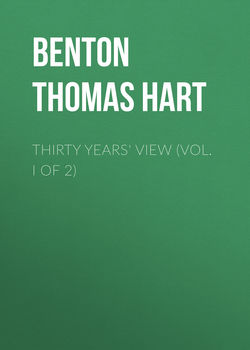Читать книгу Thirty Years' View (Vol. I of 2) - Benton Thomas Hart - Страница 6
CHAPTER III.
FINANCES. – REDUCTION OF THE ARMY
ОглавлениеThe distress of the country became that of the government. Small as the government expenditure then was, only about twenty-one millions of dollars (including eleven millions for permanent or incidental objects), it was still too great for the revenues of the government at this disastrous period. Reductions of expense, and loans, became the resort, and economy – that virtuous policy in all times – became the obligatory and the forced policy of this time. The small regular army was the first, and the largest object on which the reduction fell. Small as it was, it was reduced nearly one-half – from 10,000 to 6,000 men. The navy felt it next – the annual appropriation of one million for its increase being reduced to half a million. The construction and armament of fortifications underwent the like process. Reductions of expense took place at many other points, and even the abolition of a clerkship of $800 in the office of the Attorney General, was not deemed an object below the economical attention of Congress. After all a loan became indispensable, and the President was authorized to borrow five millions of dollars. The sum of twenty-one millions then to be raised for the service of the government, small as it now appears, was more than double the amount required for the actual expenses of the government – for the actual expense of its administration, or the working its machinery. More than half went to permanent or incidental objects, to wit: principal and interest of the public debt, five and a half millions; gradual increase of the navy, one million; pensions, one and a half millions; fortifications, $800,000; arms, munitions, ordnance, and other small items, about two millions; making in the whole about eleven millions, and leaving for the expense of keeping the machinery of government in operation, about ten millions of dollars; and which was reduced to less than nine millions after the reductions of this year were effected. A sum of one million of dollars, over and above the estimated expenditure of the government, was always deemed necessary to be provided and left in the treasury to meet contingencies – a sum which, though small in itself, was absolutely unnecessary for that purpose, and the necessity for which was founded in the mistaken idea that the government expends every year, within the year, the amount of its income. This is entirely fallacious, and never did and never can take place; for a large portion of the government payments accruing within the latter quarters of any year are not paid until the next year. And so on in every quarter of every year. The sums becoming payable in each quarter being in many instances, and from the nature of the service, only paid in the next quarter, while new revenue is coming in. This process regularly going on always leaves a balance in the treasury at the end of the year, not called for until the beginning of the next year, and when there is a receipt of money to meet the demand, even if there had been no balance in hand. Thus, at the end of the year 1820, one of the greatest depression, and when demands pressed most rapidly upon the treasury, there was a balance of above two millions of dollars in the treasury – to be precise, $2,076,607 14, being one-tenth of the annual revenue. In prosperous years the balance is still larger, sometimes amounting to the fourth, or the fifth of the annual revenue; as may be seen in the successive annual reports of the finances. There is, therefore, no necessity to provide for keeping any balance as a reserve in the treasury, though in later times this provision has been carried up to six millions – a mistake which economy, the science of administration, and the purity of the government, requires to be corrected.
